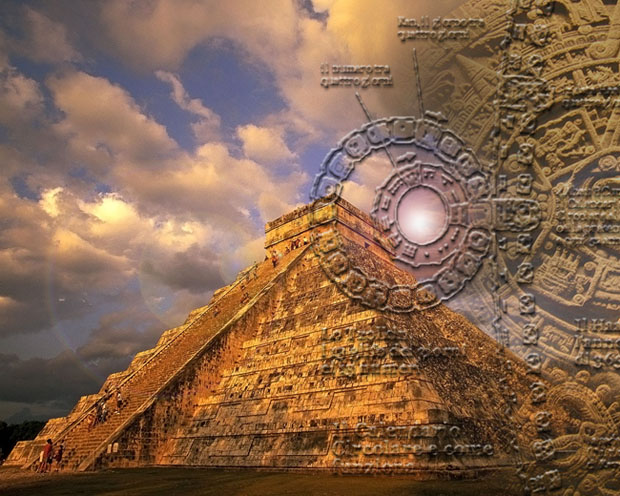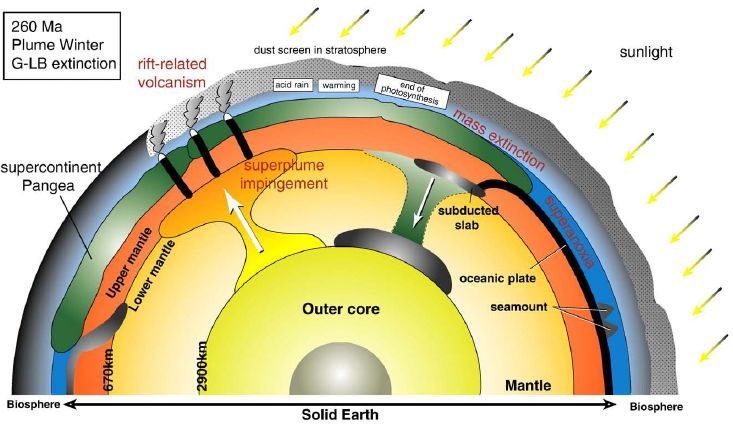| Permian Period | ||
| Paleozoic Era | Permian: 4: Illawarra Reversal and Superplume activity |
| Carboniferous | Neoproterozoic | Permian | ||
| Triassic | Mesozoic | Cisuralian | Timescale |

Every so often, the Earth's poles reverse the orientation of their magnetic field, so the north magnetic pole becomes the south and vice-versa. There is a rich and enthusiastic mythology about this in the New Age movement, according to which this event will mean the end of the world as we know it, and usher in a new spiritual age. The original idea of tying magnetic pole shift to "Earth Changes" derives from Edgar Cayce, an important American spiritual healer of the early 20th century, who became known as "the sleeping prophet" because he would deliver all his messages while in trance. More recently, the Mexican-American author and artist José Argüelles added his own idiosyncratic interpretations of this with the Mayan Calender, which conveniently ends in 2012, thus allowing three years from the time of writing (November 2009) before either the world as we know it ends or more uncritical New Age proponents have to seriously revise their mythology. In fact, the poles have switched their magnetic orientation at irregular intervals throughout the Earth's history, and not once did the world end. This can be dated through determining the magnetic orientation of crustal sea floor spreading zones and ferrimagnetic minerals in sedimentary or volcanic rock on land.
One of the most interesting and significant of these magnetic field reversals was the Capitanian age (mid Permian) Illawarra Reversal, which ended the Kiaman Reverse Superchron. (the Kiaman and Illawarra Superchrons are named after Australian localities where geological evidence of these magnetic events were first detected).
The Kiaman Superchron was a 50 million year long period of stable geomagnetism, with few or no geomagnetic reversals. It lasted from the late Carboniferous to the Middle Permian. During this period the magnetic field polarity was the opposite of what it is now. Therefore in the format of geomagnetic charts it is drawn white (whereas current north-south orientation is drawn black).
Japanese Earth Sciences researcher Yukio Isozaki has developed the intriging theory (Isozakia 2007, Isozakia 2009 link) that ties in the Illawarra Reversal, global cooling, vulcanism, the Permian mass extinctions, and the resulting radical change of conditions on Earth. His theory is that around the time of the Wordian/Capitanian boundary a plume of super-hot material fomed in the molten outer core of the Earth. The resulting thermal instability made the magnetic geodynamo in the outer core unstable, the first polarity switch being the Illawarra Reversal, which was the "fingerprint" of this event. The weakening of Earth's magnetic field exposed the surface to increased cosmic radiation. The radiation ionised the atmospheric nitrogen, which seeded for clouds. The more cosmic rays that penetrated the atmosphere, the more clouds developed, which increased the albedo (reflectivity). This in turn cooled the Earth's surface, because the sun's rays couldn't get through (the opposite of a greenhouse effect, which traps heat within the atmosphere). This resulted in the Kamura cooling event (Isozaki et al 2007). Meanwhile, the plume was slowly rising through the mantle, upsetting convection in the core, and causing the frequent polarity reversals that characterised the Late Permian to Triassic Mixed Superchron. After about five million years it reached the upper mantle, triggering supervolcanoes and causing further cooling.
This is explained in the following diagram Isozakia 2009 p.428:

Massive vulcanism could also create a greenhouse effect, which brings us to the events documented by Retallack 2005 and Retallack et al 2006
Isozaki considers the same superplume triggered the Siberian Traps and hence the end-Permian extinction. Retallack however disputes Isozakia' thesis, because life recovered and flourished between the two mass extinctions. But I don't see why these two respective hypotheses (superplume vulcanism/cosmic ray induced cooling and greenhouse/anoxic triggered extinctions) should be mutually exclusive.
The same superplume activity, according to Isozaki, triggered the breakup of Pangea, while the change in cosmic radiation may explain not only global climatic changes in the end-Guadalupian but also long-term global warming and cooling trends in Earth's history in terms of cloud coverage over the planet. The Illawarra Reversal and the Guadalupian-Lopingian boundary event thus represent the transition processes from the Paleozoic to Mesozoic and Modern world. MAK091115
Update: Jason R. Ali (2009) has pointed out a number of problems inherent in Isozaki's hypothesis, including a three million year hiatus between the end-Kiaman reversal and the mid Capitanian extinction, the time required for the plume to travel from the Core-Mantle Boundary to the surface being certainly greater than the 10 Million or spo years of the late Permian, problematic statements regarding the streingth of the geomagnetic field as reveiled through paleomagnetism, the timing of vulcanism worldwide, and the main Mid Permian extinction event associated with vulcanism being middle Capitanian rather than end-Guadalupian. MAK120127